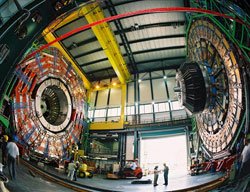University of Minnesota physicists play role in ground-breaking research at CERN

The Large Hadron Collider (LHC) at CERN in Geneva, Switzerland, launched a new era for particle physics when the first particles collided at the record energy of seven trillion electron volts (7 TeV).
The new collisions mark the start of a decades-long LHC research program at an energy three and a half times higher than previously achieved at a particle accelerator. CERN will run the LHC for 18-24 months with the objective of delivering enough data to the experiments to make significant advances across a wide range of physics channels.
University of Minnesota physicists were in CERN and shared the excitement for the ground-breaking achievement and what it will mean to physics research, including progress in the hunt for dark matter, new forces and new dimensions.
Professor Roger Rusack is one of the half dozen University of Minnesota physicists currently in CERN working on the project. Over the years, more than 100 researchers and students at the University of Minnesota are among the 1,700 international scientists and engineers who have collaborated on designing and building the LHC accelerator and massive particle detectors.
Rusack has been actively involved with the LHC since the beginning of the project in 1993. He helped design and develop many components of the detector and has contributed to the scientific effort and management. He currently is the project manager for the electromagnetic calorimeter, one of the large international components of the 90-ton crystal detector.
"We are very excited and exhausted," said Rusack. "It's been a long road to get to this point, but the next two years will provide us with exciting new data that can help us answer great scientific mysteries such as the nature of dark matter and our place in the cosmos." Rusack also pointed out that University of Minnesota has been a big player in this research from the very beginning.
"The University of Minnesota has been involved in two major construction projects. This has been a very positive learning opportunity for faculty and students at the University," he said.
University of Minnesota physics assistant professor Jeremiah Mans and his students have been involved with the LHC's design, building and maintenance of the timing and laser control electronics and the data acquisition software for the Hadron Calorimeter, which will measure the energies of quark-containing particles. The group will also be involved in various aspects of analyzing the data from the LHC.
"Today's achievement of collisions at 7 TeV has opened the door to what we hope is a vast "hall" full of new and deeper understandings about the universe and the interactions between particles," Mans said. "Exploring the hall will take some time, as our "flashlight" (the beams of the LHC) is a bit dim right now. Through the summer, the accelerator groups will increase the beam intensity and we will be able to see more of what's present in this new treasure hall."
